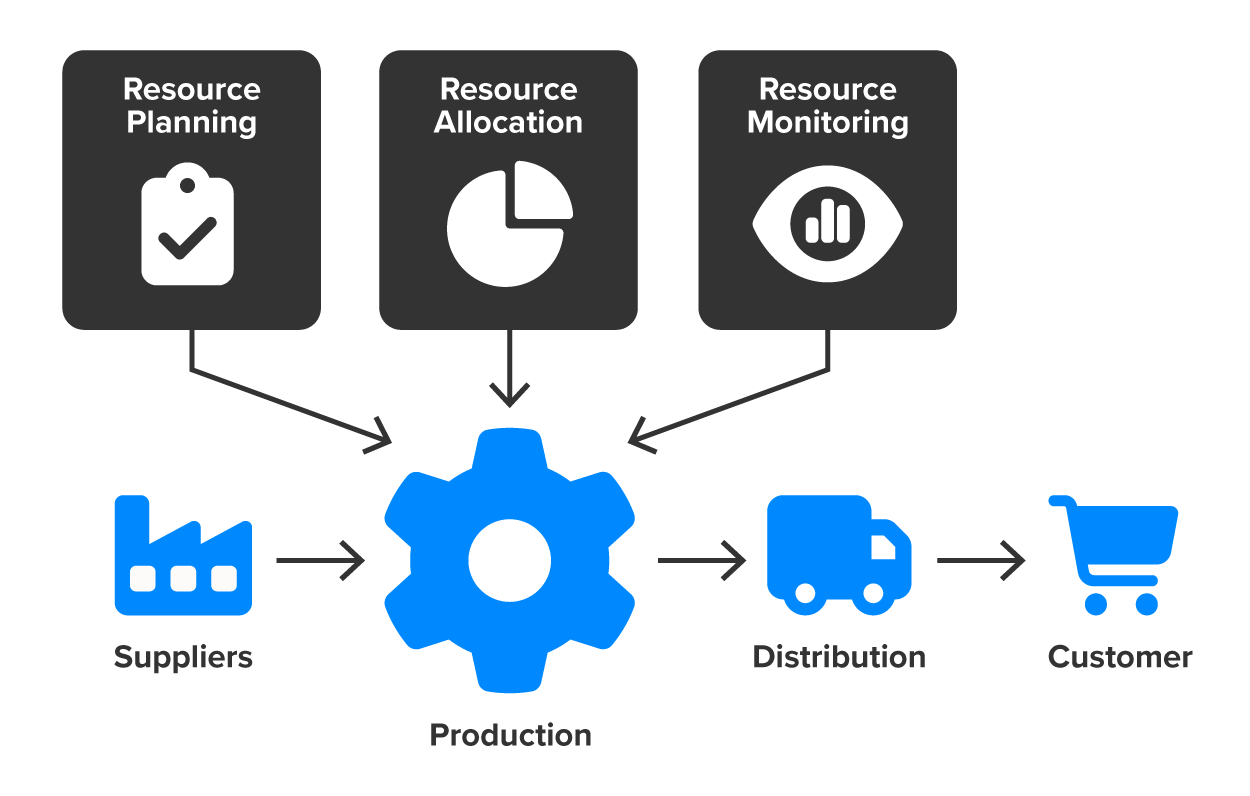Table of Contents |
To ensure the availability of the correct resources precisely when needed, in the proper amount, and at the most cost-effective price, firms must ensure that the resources needed for production—such as raw materials, parts, equipment, and labor—will be available at strategic moments in the production process.

Resource planning involves identifying, forecasting, allocating, and managing essential resources—including people, materials, equipment, finances, and time—to guarantee the efficient achievement of business goals.
This can be a huge challenge. The components used to build just one Boeing airplane, for instance, number in the millions. Cost is also an important factor. In many industries, the cost of materials and supplies used in the production process amounts to as much as half of sales revenues. Resource planning is, therefore, a big part of any firm’s production strategy.
When considering resource planning in the supply chain, several major areas must be addressed to ensure efficient and cost-effective operations. One of the most essential elements is material planning, often managed through material requirements planning (MRP) systems, which we’ll look at in an upcoming section. This process ensures that the right raw materials and components are available when needed for production, helping to avoid both shortages and excess inventory. Closely tied to this is capacity planning, which evaluates whether the current facilities, equipment, and labor can meet the expected production volume. It helps organizations determine if additional resources or adjustments are necessary to meet demand.
Another critical component is workforce planning, also known as human resource planning (HRP). This focuses on ensuring that the right number of skilled employees are in place to meet production and delivery timelines. It also involves forecasting workforce needs based on current and future workloads. In parallel, financial resource planning ensures that sufficient funding is available to support purchasing, manufacturing, and logistics activities. This alignment of budgetary resources with operational needs is vital for maintaining smooth and scalable operations.
Equipment and facility planning is equally important as it ensures that physical assets such as machinery and warehouses are properly maintained, adequately staffed, and capable of supporting production goals. These elements work together to help organizations optimize their supply chains and respond effectively to market demands.
Resource planning typically begins by identifying which raw materials, parts, and components will be required—and when—to produce finished goods. This requires forecasting the expected quantity of finished products and creating a bill of materials (BOM), which lists all necessary items and their quantities. The BOM acts like a blueprint or recipe for building a product, helping teams understand all the components, supplies, and materials needed. Once the materials are identified, purchasing or the procurement process begins, involving the purchase of production inputs from various suppliers.
See if you can identify how Tasha, the owner of Glow & Grace Salon, might handle resource planning for her salon:
IN CONTEXT: Resource Planning at Glow & Grace Salon
Glow & Grace Salon is gearing up for prom and wedding season. Tasha expects a surge in appointments for hair styling, makeup, and spa services. To prepare, Tasha begins her resource planning by reviewing her material inventory. She checks her stock of hair color, shampoos, styling products, disposable tools (like waxing strips and gloves), and makeup supplies. She notices she’s low on certain shades of hair dye and decides to place a bulk order with her supplier to avoid running out during peak season.
Next, she looks at her workforce capacity. Her current team of five stylists and two aestheticians is already booked for the next few weekends. To handle the increased demand, she plans to bring in a freelance makeup artist on Saturdays and extend weekday hours temporarily. She adjusts the schedule to ensure there’s no overlap or burnout and confirms everyone’s availability in advance.
Tasha then reviews her equipment and facility needs. She arranges for maintenance on the blow dryers and treatment beds and orders a new chair for the extra stylist she’ll bring on. She also reorganizes the backroom to make space for additional products and tools.
For financial planning, she updates her monthly budget to include extra payroll, supply costs, and minor facility upgrades. She plans a small promotional campaign on social media to drive bookings, so she sets aside funds for that as well.
By carefully planning her resources—people, products, time, and money—Tasha ensures that Glow and Grace is fully prepared to deliver high-quality service, maximize revenue, and maintain client satisfaction during the busiest months of the year.
As part of resource planning, companies need to decide whether to make their own production materials or buy them from outside sources. This is the make-or-buy decision. The quantity of items needed is one consideration. If a part is used in only one of many products, buying the part may be more cost effective than making it. Buying standard items, such as screws, bolts, rivets, and nails, is usually cheaper and easier than producing them internally. Purchasing larger components from another manufacturer can be cost effective as well. When items are purchased from an outside source instead of being made internally, it is called outsourcing.
EXAMPLE
 Harley-Davidson purchases its tires, brake systems, and other motorcycle components from manufacturers that meet its specifications.
Harley-Davidson purchases its tires, brake systems, and other motorcycle components from manufacturers that meet its specifications.
However, if a product has special design features that need to be kept secret to protect a competitive advantage, a firm may decide to produce all parts internally.
In deciding whether to make or buy, a firm must also consider whether outside sources can provide the high-quality supplies it needs in a reliable manner. Having to shut down production because vital parts aren’t delivered on time can be a costly disaster. Just as bad are inferior parts or materials, which can damage a firm’s reputation for producing high-quality goods. Therefore, firms that buy some or all of their production materials from outside sources should make building strong relationships with quality suppliers a priority.
A firm’s inventory consists of the goods it holds for use in production or for sale to customers. Deciding how much inventory to keep on hand is one of the biggest challenges facing operations managers. On the one hand, with large inventories, the firm can meet most production and customer demands. Buying in large quantities can also allow a company to take advantage of quantity discounts. On the other hand, large inventories can tie up the firm’s money, are expensive to store, and can become obsolete.
Inventory management involves deciding how much of each type of inventory to keep on hand and ordering, receiving, storing, and tracking it. The goal of inventory management is to keep down the costs of ordering and holding inventories while maintaining enough on hand for production and sales. Good inventory management enhances product quality, makes operations more efficient, and increases profits. Poor inventory management can result in dissatisfied customers, financial difficulties, and even bankruptcy.
One way to determine the best inventory levels is to look at three costs:
Let’s look at how poor inventory management could have a negative impact on Tasha’s business:
IN CONTEXT: Problems at Glow & Grace Salon
It’s a busy Saturday at Glow & Grace Salon, and Tasha is fully booked with bridal party appointments. One bride-to-be and her bridesmaids arrive for their scheduled hair coloring and makeup sessions. However, as the team gets started, Tasha realizes that they’ve run out of the specific shade of blonde hair dye the bride requested—a shade she uses often but forgot to reorder. To make matters worse, the salon is also low on foundation colors that match two of the bridesmaids’ skin tones.
Tasha scrambles to find alternatives, but the substitute hair color isn’t what the bride had in mind, and the makeup options don’t blend well. The clients become frustrated and disappointed, feeling that their big day has been compromised. Despite the staff’s best efforts, the overall experience falls short of expectations.
The bride later posts a negative review online, mentioning that she felt unprepared and poorly treated due to the salon’s lack of organization. Tasha not only loses potential repeat business from this group but also sees a dip in new appointment bookings following the bad publicity.
This situation highlights how poor inventory management—not tracking product levels, failing to reorder in time, and not anticipating high-demand periods—can directly lead to dissatisfied customers, damage to reputation, and lost revenue.
To control inventory levels, managers often track the use of certain inventory items. Most companies keep a perpetual inventory, a continuously updated list of inventory levels, orders, sales, and receipts, for all major items. Today, companies mostly use computers to track inventory levels, calculate order quantities, and issue purchase orders at the right times.
Companies use technology for resource planning to streamline operations, improve accuracy, and enhance decision making. Through systems like enterprise resource planning (ERP) software, businesses can integrate data from various departments—such as inventory, finance, human resources, and production—into one centralized platform. This allows managers to track resource availability in real time, forecast demand more accurately, automate purchasing and scheduling, and reduce waste.
Technologies like cloud computing, data analytics, and artificial intelligence (AI) further enhance resource planning by providing predictive insights and enabling faster, more informed responses to changes in customer demand or supply chain disruptions.
EXAMPLE
 AI can analyze large volumes of data to predict inventory needs, identify bottlenecks, and recommend optimal staffing or scheduling solutions.
AI can analyze large volumes of data to predict inventory needs, identify bottlenecks, and recommend optimal staffing or scheduling solutions.
These types of systems can also analyze historical data, market trends, and patterns to forecast demand, which means resource plans can be more accurate. Similarly, material requirements planning (MRP) systems help businesses calculate the materials and components needed for production, based on the current inventory levels and future demand forecasts. By leveraging these tools, companies can optimize resource use, reduce costs, improve efficiency, and stay competitive in a dynamic market.
A supply chain is the system that connects all the people, companies, and processes involved in making and delivering a product—from the raw materials to the final customer. It’s a key part of resource management, helping businesses get the right materials at the right time and cost.
Supply chains also provide important information, like how much inventory is available, what customers might need, and how well suppliers are performing. This helps managers make smart decisions. They also help control costs by improving how companies buy materials, store goods, and move products. And since supply chains rely on people to handle logistics, manufacturing, and delivery, workforce planning is also important.
In the past, companies often had tense relationships with suppliers. They used many suppliers and switched often, trying to get the best deal. Communication was limited to basic paperwork like orders and invoices.
Today, things are different. Many businesses now work closely with their suppliers. These partnerships help reduce delays, improve product quality, lower costs, and encourage innovation. Strong relationships also make supply chains more flexible and better able to handle unexpected problems. Overall, collaboration makes the supply chain more reliable and competitive.
IN CONTEXT: Apple Supply Chain Management
Apple is a great example of effective supply chain management. Apple coordinates with numerous suppliers around the world to source components like chips, screens, and batteries for its iPhones. The company carefully plans production schedules based on demand forecasts and manages inventory to avoid shortages or excess stock. Apple also oversees the assembly of its products in factories, primarily in Asia, and organizes transportation to distribute the finished phones to retailers and customers worldwide.
By closely monitoring supplier performance, tracking shipments, and responding quickly to any disruptions, Apple ensures that its products are delivered on time while maintaining high quality and controlling costs. This complex, well-coordinated supply chain is a key reason for Apple’s success in the competitive smartphone market.
Source: THIS CONTENT HAS BEEN ADAPTED FROM RICE UNIVERSITY’S “INTRODUCTION TO BUSINESS”. ACCESS FOR FREE AT OpenStax. LICENSE: CREATIVE COMMONS ATTRIBUTION 4.0 INTERNATIONAL.